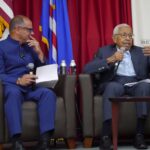Fifteen years ago, the U.S. Department of Education found black students were getting the boot far faster and in much bigger numbers than white students. While blacks made up then less than 20 percent of the nation’s public school students, they comprised nearly one out of three students kicked out of the schools. Things were so bad then that the NAACP held public hearings nationally on the racial disparities in school discipline. The hearings were timely and needed but they didn’t change anything.
The recent Department of Education survey on racial disparities in public education found that black students were still getting the boot from schools faster than any other group, and that included black females, who were disproportionately suspended and expelled more than white females from schools. But it also found that the students were getting suspended in astoundingly disproportionate numbers even before they ever set foot in a regular school classroom. According to figures, nearly 50 percent of preschoolers who received more than one suspension were blacks. This was double that of white students though blacks made up less than 20 percent of public school preschoolers.
No matter what age they were suspended or expelled, the students were far more likely to wind up in police stations and courtrooms after removal. This cast an even harsher glare on the stiff punishment school officials routinely dish out to black students who allegedly misbehave. It’s no overreach or apology for misconduct to say “allegedly” about the reasons for their suspensions, expulsions and often arrest. Teams of academics closely examined the notion that black students were more violent, disruptive or menacing than white students. They found that the disparities in suspensions didn’t result from blacks “acting out” in the classroom more than whites. The heavy-handed oust of black students from schools is also a major factor in the grossly high dropout rate of black students from many inner city schools.
Many teachers and administrators expel and suspend more black students than white students, and school officials and district attorneys prosecute them in greater numbers, because of racial fear and ignorance. When some young blacks turned to gangs, guns and drugs and terrorized their communities, much of the press titillated the public with endless features on the crime-prone, crack-plagued, blood-stained streets of the ghetto. TV action news crews turned into a major growth industry, stalking black neighborhoods, filming busts for the nightly news. The explosion of gangster rap and the spate of Hollywood ghetto films convinced many Americans that the thug lifestyle was the black lifestyle. They have ghastly visions of young blacks menacing their neighborhoods.
In addition, school principals have near dictatorial power. They set the standards of what is acceptable behavior or not, and once that’s done and a student is deemed a discipline problem, there isn’t much parents can do to reverse a decision to suspend or expel. In fact, studies have found that poor and minority parents are less likely than white, middle-class parents to challenge school officials decisions to suspend or expel their children.
There are two other reasons that school officials grossly overreact to the real or perceived bad behavior of some black students. The federal Gun-Free Schools Act, passed in 1994, requires that states order their schools to kick students out for weapons possession in order to qualify for federal funds. (School officials later expanded the list of violations for student expulsion to include fighting and other violent acts.) California’s zero-tolerance school laws, for instance, mandate that a student be expelled for one year for infractions that include drug sales, robbery, assault, weapons possession and fights that cause serious physical injury. The only exception is if the student that caused the injury acted in self-defense.
The horrific stories of students wielding guns and knives on campuses and assaulting and terrorizing other students have deepened public panic that murderous youths are running amok at schools. School officials zealously enforce get-tough policies to prove that they will do whatever it takes to get rid of disruptive students. The danger is that school officials that reflexively view young blacks as violence-prone, menace-to-society thugs have turned zero-tolerance into a repressive tool that victimizes black students.
As the survey shows, the quick-trigger suspension and expulsion of black students from schools at the drop of a dime has reached down into preschools and preconditioned far too many teachers and principals to regard black children who are barely removed from the crib as classroom dangers. The end result is that the school-to-prison pipeline has become even more unyielding and socially damaging because it starts at an even earlier age. This will end only when school officials stop the racial profiling of black students, and that first and foremost now includes black children.
Earl Ofari Hutchinson is an author and political analyst. He is a frequent MSNBC contributor. He is an associate editor of New America Media. He is a weekly co-host of the Al Sharpton Show on American Urban Radio Network. He is the host of the weekly Hutchinson Report on KTYM 1460 AM Radio Los Angeles and KPFK-Radio and the Pacifica Network. Follow Earl Ofari Hutchinson on Twitter: http://twitter.com/earlhutchinson






